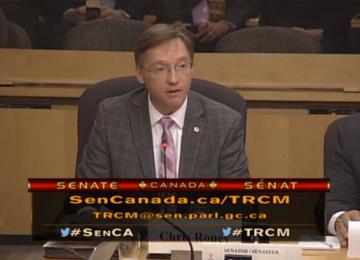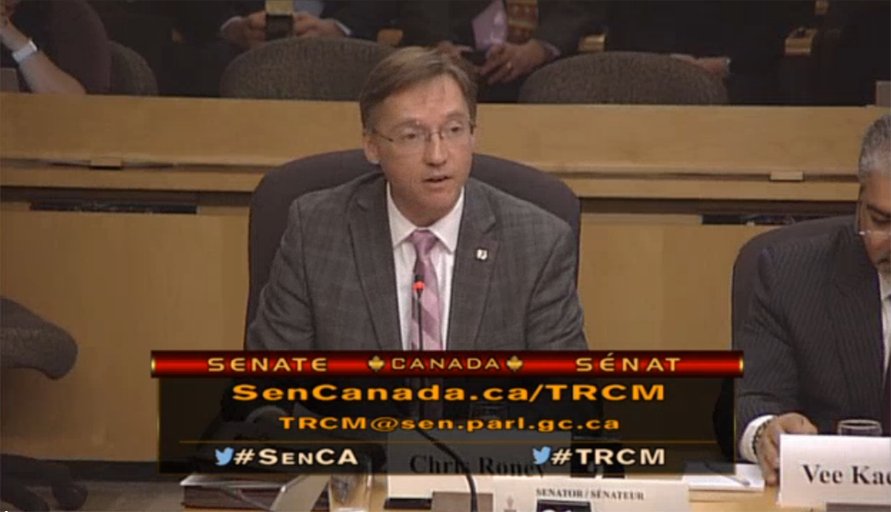

 By: Chris Roney, FEC, P.Eng., IntPE, Past-President, Engineers Canada
By: Chris Roney, FEC, P.Eng., IntPE, Past-President, Engineers Canada
Thank you for the opportunity to appear here today, Mr. Chair on behalf of Engineers Canada, and to present our recommendations for Bill C-49.
Our testimony today pertains directly to Section 11 of the Railway Safety Act, specifically in relation to the design, build, and maintenance stages of railway work in Canada. There are two recommendations that I will discuss.
The first is: that licensed professional engineers be involved in the entire life cycle of railway infrastructure.
Licensed engineers are required to meet high standards of knowledge, skill and experience, and are bound to a stringent code of ethical conduct. And, most importantly, they are accountable to the public for their work. In fact, professional engineers, unlike the other major learned professions, are required to place the public welfare above all else – even above their own employers. This paramount duty includes the safeguarding of life, health, property, economic interests, and the environment. It’s one of the key things that sets a licenced engineer apart from others who may be charged with safeguarding Canada’s infrastructure.
Key decisions and directions must to be made on the basis of unbiased sound engineering advice and expertise, that balances costs with long term benefits, whilst never compromising on public welfare. This is why it is so critical that professional engineers be at the table guiding the process throughout the entire life cycle of rail projects.
Recent events have painfully demonstrated the importance of ensuring that we have in place the right people, with the right knowledge and skills, who are both unbiased and accountable for the public good wherever our country’s infrastructure in concerned.
It’s also essential in ensuring that we have a resilient rail infrastructure.
This brings me to the second recommendation: that climate vulnerability assessments be carried out on Canada’s rail infrastructure and that it be adapted to the potential risks associated with a changing climate.
Resiliency in civil infrastructure is the driving force behind productive societies, stable industries, and increased public confidence. However, Canada’s Infrastructure Report Card noted that much of Canada’s current infrastructure is vulnerable to the effects of extreme weather, and this presents an avoidable risk, not only to public safety, but also to the country’s economy.
For example, floods and record high water flows severely damaged the Hudson Bay Railway line this past May. This event damaged five bridges, washed away 19 sections of trackbed, and required a significant number of bridges and culverts to be re-assessed. This specific rail line transports food, supplies, and people to the remote community of Churchill; which is a popular tourist destination. The railway service disruptions have caused goods, services, and people to resort to air transportation – at great expense.
With objective climate vulnerability assessments, infrastructure owners, managers and others can gain an early awareness of the potential impacts that extreme weather events could have on infrastructure serving communities across the country, and can plan and build accordingly. Engineers Canada, in collaboration with Natural Resources Canada, has developed a climate risk assessment tool that can greatly enhance the resilience of infrastructure, and decrease the severity of climate impacts on individual and business economic interests. The Public Infrastructure Engineering Vulnerability Protocol, known as PIEVC, gives engineers, as well as others, a tool to design and construct rail infrastructure that will withstand our rapidly changing climate. The Protocol has been applied to infrastructure systems more than 40 times in Canada and three times internationally.
We strongly encourage the federal government to adopt assessment and prevention tools, such as PIEVC, to be a condition for: funding approvals; acceptance of environmental impact assessments; and approving projects that involve rehabilitation, maintenance and decommissioning of existing infrastructure. This will contribute to the safeguarding of the environment, the economy, and public safety.
Mr. Chair, thank you for allowing Engineers Canada to present to the committee today. We truly hope that the committee will recognize the integral role that professional engineers play in Canada’s transportation and infrastructure sectors, and I wish to assure you that our profession is ready and willing to ensure that Canada’s railway system is resilient, safe, and continues to be an enabler of Canada’s economy.


